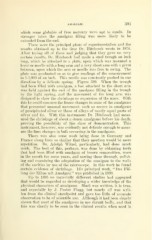Page 625 - My FlipBook
P. 625
AMALGAM. 303
which some globules of free mercury were apt to exude. In
stronger tubes the amalgam filling was more likely to be
extended from the end.
These were the principal plans of experimentation and the
results obtained up to the time Dr. Hitchcock wrote in 1874.
After trying all of these and judging that they gave no very
certain results, Dr. Hitchcock had made a steel trough an inch
long, which he attached to a plate, upon which was mounted a
lever or needle with a long arm and a very short arm with a pivot
between, upon which the arm or needle was free to swing. The
plate was graduated so as to give readings of the measurement
to 1-1,000 of an inch. This needle was constantly pushed in one
direction by a delicate spring. Figure 399. When the trough
had been filled with amalgam, a bar attached to the short arm
was held against the end of the amalgam filling in the trough
by the light spring, and the movement of the long arm was
designed to show the shrinkage or expansion of the mass. With
this he could measure the linear changes in some of the amalgams
that presented unusual movement, such as occurs in amalgams
of precipitated silver or those of alloys of nearly equal parts of
silver and tin. With this instrument Dr. Hitchcock had meas-
ured the shrinkage of about a dozen amalgams before his death,
proving the possibility of this class of demonstration. This
instrument, however, was evidently not delicate enough to meas-
ure the finer changes in bulk occurring in the amalgams.
There was also some work being done in Germany and
France along lines so similar that their mention would be mere
repetition. Dr. Adolph Witzel, particularly, had done much
work. The best of this, perhaps, was done by obtaining teeth
that had been filled with amalgam of known composition, worn
in the mouth for some years, and sawing these through, polish-
ing and examining the adaptation of the amalgam to the walls
of the cavities by use of the microscope. In this work he found
certain evidence of shrinkage. His principal work, "Das Fiil-
lung der Zahne mit Amalgam" was published in 1899.
Up to 1895 no materially different studies had appeared
that would be regarded as developing a wider knowledge of the
physical characters of amalgams. Much was written, it is true,
and especially by J. Foster Flagg, but nearly all was writ-
ten from the clinical standpoint and gave too little of accurate
observation to be of scientific use. Although it had been clearly
shown that most of the amalgams in use shrunk badly, and that
this was clearly to be seen in the clinical results when used in


